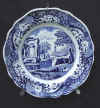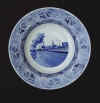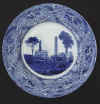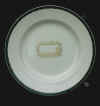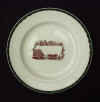Blue and White(haven) THIS IS AN ARCHIVED PAGE FROM THE OLD ARTCUMBRIA WEB SITE |
| . |
| .Whitehaven was the home of the Cumbrian pottery industry from 1819 to 1877, producing ceramics similar in nature to those made in Stoke, and other regional potteries. The Beacon has a fine collection of wares from the Whitehaven Potteries, including blue and white printed ceramics, and other monochromatic wares. Much of the ware is decorated by selected and altered contemporary prints of the time, images of the European Tour and the exotic . Also in the collection are more recent objects, examples of pottery with images promoting political campaigns of the time, and souvenir ware from Seascale and other Cumbrian holiday resorts. |
|
Referencing the collection of Whitehaven ceramics, Paul Scott produced an exhibition of work, which examined the contemporary Cumbrian landscape highlighting, sometimes controversial, issues and events. Scott focused on two quite different aspects of industry in the landscape: The first, traditionally perceived architectural monuments, factories in the rural idyll that is promoted as Cumbria, with scenes of the Sellafield Nuclear re-processing plant amidst the trees and rolling hills of its rural surrounds, and Marchon, the detergent factory atop the cliffs above Whitehaven hemmed in by its surrounding tree-less council estate. In some of the Marchon pieces, Scott used similar artistic license used by the ceramic printers, by adding features or re-configuring the ‘real’; in this case adding trees to the three vignettes of roads to the plant, faming them with a re-configured Marseillaises patterned border lifted from a Whitehaven Potteries pattern. |
|
The view from Seascale on an old china cup is updated to include the contemporary landscape with the Sellafield nuclear plant in the distance, and souvenir Presents from Whitehaven, Workington and Fimby show the Council Estate, Workington Docks and Flimby’s Wind Turbines… Secondly, Scott commemorated the tragedy of the 2001 Foot and Mouth outbreak on the agricultural industry, the animals and lives of the people of Cumbria. Having lived in a small agricultural village in West Cumbria for over twenty years, Scott was acutely aware of the reality of the impact of the disease, not only on farmers and farm workers but on other people living and working in the countryside. Passing burning pyres for several weeks on leaving his home, or piles of dead sheep in the fields he felt it essential to make work which in some way commemorated the event, and its effect on the landscape. Using images first created by Thomas Bewick Scott erased all traces of sheep or cows, leaving blank spaces where once they had been. Using laser printed decals on earthenware, these images were given further poignancy as they sank in faded sepia into the glazed surfaces of plates and bowls. In one piece the old puzzle jug (from the Copeland Collection) English Farmstead, but where is the Farmer? became English Farmstead but where are the animals?… the animals clearly on view in front of the farm in a pyre. Constructed from by collaging several Bewick images, the piece prefaced a more brutal and literal piece, Foot and Mouth Carving Platter. The contemporary work was exhibited alongside historical pieces from the collection..... Pottery is commonly collected by private and public collectors. One of the aims of the exhibition was to try and span the chasm that exists between collectors of contemporary art and ceramics, and those collectors of industrial pottery, to instigate some sort of debate or dialogue about the common issues that exist in the collecting field. As a result of the exhibition, three writers were commissioned to examine the issues that inform collectors and buyers of ceramics.
|
| | Beacon Gallery | |




